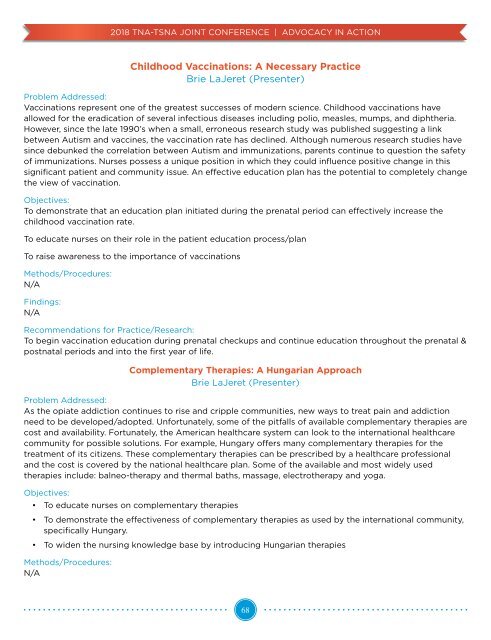2018 TNA and TSNA Joint Annual Conference
Create successful ePaper yourself
Turn your PDF publications into a flip-book with our unique Google optimized e-Paper software.
<strong>2018</strong> <strong>TNA</strong>-<strong>TSNA</strong> JOINT CONFERENCE | ADVOCACY IN ACTION<br />
Childhood Vaccinations: A Necessary Practice<br />
Brie LaJeret (Presenter)<br />
Problem Addressed:<br />
Vaccinations represent one of the greatest successes of modern science. Childhood vaccinations have<br />
allowed for the eradication of several infectious diseases including polio, measles, mumps, <strong>and</strong> diphtheria.<br />
However, since the late 1990’s when a small, erroneous research study was published suggesting a link<br />
between Autism <strong>and</strong> vaccines, the vaccination rate has declined. Although numerous research studies have<br />
since debunked the correlation between Autism <strong>and</strong> immunizations, parents continue to question the safety<br />
of immunizations. Nurses possess a unique position in which they could influence positive change in this<br />
significant patient <strong>and</strong> community issue. An effective education plan has the potential to completely change<br />
the view of vaccination.<br />
Objectives:<br />
To demonstrate that an education plan initiated during the prenatal period can effectively increase the<br />
childhood vaccination rate.<br />
To educate nurses on their role in the patient education process/plan<br />
To raise awareness to the importance of vaccinations<br />
Methods/Procedures:<br />
N/A<br />
Findings:<br />
N/A<br />
Recommendations for Practice/Research:<br />
To begin vaccination education during prenatal checkups <strong>and</strong> continue education throughout the prenatal &<br />
postnatal periods <strong>and</strong> into the first year of life.<br />
Complementary Therapies: A Hungarian Approach<br />
Brie LaJeret (Presenter)<br />
Problem Addressed:<br />
As the opiate addiction continues to rise <strong>and</strong> cripple communities, new ways to treat pain <strong>and</strong> addiction<br />
need to be developed/adopted. Unfortunately, some of the pitfalls of available complementary therapies are<br />
cost <strong>and</strong> availability. Fortunately, the American healthcare system can look to the international healthcare<br />
community for possible solutions. For example, Hungary offers many complementary therapies for the<br />
treatment of its citizens. These complementary therapies can be prescribed by a healthcare professional<br />
<strong>and</strong> the cost is covered by the national healthcare plan. Some of the available <strong>and</strong> most widely used<br />
therapies include: balneo-therapy <strong>and</strong> thermal baths, massage, electrotherapy <strong>and</strong> yoga.<br />
Objectives:<br />
• To educate nurses on complementary therapies<br />
• To demonstrate the effectiveness of complementary therapies as used by the international community,<br />
specifically Hungary.<br />
• To widen the nursing knowledge base by introducing Hungarian therapies<br />
Methods/Procedures:<br />
N/A<br />
68

















